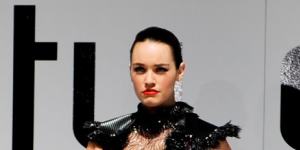Nationally,the is 14.5 per cent,but when all payments including bonuses and superannuation are included,the pay gap grows to 19 per cent.
Gender pay gap data from the Workplace Gender Equality Agency shows that in the retail trade industry,the median total remuneration pay gap is much lower,at 7.1 per cent.

City Chic’s median total remuneration pay gap is 57 per cent.Supplied
But several Australian retail favourites including plus-sized fashion brand City Chic,jewellery store Pandora and clothing brand Forever New had large median pay gaps in favour of men. They had a higher proportion of men in senior management than more junior roles,while women made up the bulk – or all – of their storefront workers.
On its website,activewear brand Lorna Jane says:“We live and breathe to inspire women.”
But the brand,which employs 1382 women and 47 men,has a median total remuneration pay gap of 37 per cent.

The company’s lawyers said in a statement the pay gap was the difference in average earnings between its men and women. Men and women were paid the same rate for the same jobs.
“As one of Australia’s leading women’s activewear manufacturers,Lorna Jane’s retail team,across its network of 101 stores,is 100 per cent female and makes up over 97 per cent of its total workforce,” the statement said.
“Lorna Jane consistently aims to provide the most attractive employment conditions for its team,which not only includes wage and salary levels but also the ability to offer women,in particular,the working hours and other flexibility benefits they often need.”
The firm’s lawyers said a failure to accurately report on the survey result had the potential to cause serious damage to the business and it would take any necessary legal action to protect its interests.
While only 3 per cent of Lorna Jane’s workforce is male,the gender equality agency’s data shows they make up 43 per cent of senior management roles.
Workplace Gender Equality Agency chief executive Mary Wooldridge said equal pay for equal work had been the law for more than 50 years,but the data showed that higher-earning roles tended to be more male-dominated,while lower-paying roles were more feminised.
“So,what we see overall is that in the highest-earning group,men are twice as likely to be in that group than women,and in the lowest-earning group,women are 50 per cent more likely to be there than men,” she said on Tuesday.
“That really goes to the heart of a number of the issues that we need to change to improve these numbers.”

City Chic’s website said it was a “family of brands empowering curvy women across the globe to embrace who they are and unite their passion for style”. The company’s median total remuneration pay gap is 57 per cent.
Half of its key management personnel and about a quarter of its executives,general managers and other managers were men,while all its sales,administrative and clerical staff were women. City Chic was contacted for comment.
A spokesperson for City Chic said the plus-sized brand was committed to gender equality in pay,and gender diversity in employment practices where appropriate.
“Men and women that hold equivalent roles are on equivalent pay,” they said in a statement.
At jewellery brand Pandora,with a median pay gap of 52 per cent,all of its executives and general managers were men,while 98 per cent of all non-managers including sales workers and administration staff were women.
Nearly half (45 per cent) of clothing brand Forever New’s executives and general managers were men,while all sales workers and labourers were women. It has a pay gap of 51 per cent.
Swimwear brand Seafolly also has a large pay gap,of 45 per cent. A third of key management personnel were men and all sales workers were women.
Michael Hill Jeweller’s base salary median pay gap is 27 per cent,but that increased to 37 per cent when bonuses and super were included. All its key management personnel and more than half (55 per cent) of its senior management team were men,while the vast majority of sales,clerical and administrative workers were women.
Pandora,Forever New,Michael Hill and Seafolly were all contacted for comment.
Many other brands had neutral pay gaps,or pay gaps that favoured women. Those companies also tended to have a greater proportion of women in higher-paid management roles.
Prouds Jewellers and David Jones have pay gaps of 0 per cent,while makeup brand Sephora and athleticwear company Lululemon had pay gaps of -1 per cent,favouring women.
At Prouds,61 per cent of its senior managers were women while all key management personnel including the CEO were men. A fifth of its clerical and administrative staff were also men.
At David Jones,the majority of staff at all levels up to senior management and nearly half of both executives and general managers (41 per cent) and key management personnel (45 per cent) were women.
Sydney-based fashion label Carla Zampatti had the largest pay gap in favour of women,at -20 per cent. Women made up 87 per cent of all managers and 88 per cent of all non-managers.
Minister for Women Katy Gallagher said businesses could no longer hide behind industry averages when it came to the gender pay gap.
“[It is] giving consumers the knowledge,giving them the information … what they do with that is up to them,” Gallagher said.
“People change their behaviour,and that’s what we’re hoping for here.”
Cut through the noise of federal politics with news,views and expert analysis from Jacqueline Maley. Subscribers can sign up to our weekly Inside Politics newsletter.